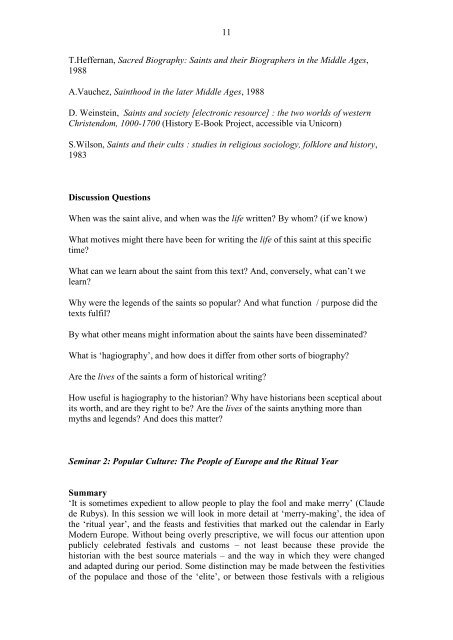Ritual, Myth and Magic in Early Modern Europe - University of Reading
Ritual, Myth and Magic in Early Modern Europe - University of Reading
Ritual, Myth and Magic in Early Modern Europe - University of Reading
Create successful ePaper yourself
Turn your PDF publications into a flip-book with our unique Google optimized e-Paper software.
11<br />
T.Heffernan, Sacred Biography: Sa<strong>in</strong>ts <strong>and</strong> their Biographers <strong>in</strong> the Middle Ages,<br />
1988<br />
A.Vauchez, Sa<strong>in</strong>thood <strong>in</strong> the later Middle Ages, 1988<br />
D. We<strong>in</strong>ste<strong>in</strong>, Sa<strong>in</strong>ts <strong>and</strong> society [electronic resource] : the two worlds <strong>of</strong> western<br />
Christendom, 1000-1700 (History E-Book Project, accessible via Unicorn)<br />
S.Wilson, Sa<strong>in</strong>ts <strong>and</strong> their cults : studies <strong>in</strong> religious sociology, folklore <strong>and</strong> history,<br />
1983<br />
Discussion Questions<br />
When was the sa<strong>in</strong>t alive, <strong>and</strong> when was the life written? By whom? (if we know)<br />
What motives might there have been for writ<strong>in</strong>g the life <strong>of</strong> this sa<strong>in</strong>t at this specific<br />
time?<br />
What can we learn about the sa<strong>in</strong>t from this text? And, conversely, what can‘t we<br />
learn?<br />
Why were the legends <strong>of</strong> the sa<strong>in</strong>ts so popular? And what function / purpose did the<br />
texts fulfil?<br />
By what other means might <strong>in</strong>formation about the sa<strong>in</strong>ts have been dissem<strong>in</strong>ated?<br />
What is ‗hagiography‘, <strong>and</strong> how does it differ from other sorts <strong>of</strong> biography?<br />
Are the lives <strong>of</strong> the sa<strong>in</strong>ts a form <strong>of</strong> historical writ<strong>in</strong>g?<br />
How useful is hagiography to the historian? Why have historians been sceptical about<br />
its worth, <strong>and</strong> are they right to be? Are the lives <strong>of</strong> the sa<strong>in</strong>ts anyth<strong>in</strong>g more than<br />
myths <strong>and</strong> legends? And does this matter?<br />
Sem<strong>in</strong>ar 2: Popular Culture: The People <strong>of</strong> <strong>Europe</strong> <strong>and</strong> the <strong>Ritual</strong> Year<br />
Summary<br />
‗It is sometimes expedient to allow people to play the fool <strong>and</strong> make merry‘ (Claude<br />
de Rubys). In this session we will look <strong>in</strong> more detail at ‗merry-mak<strong>in</strong>g‘, the idea <strong>of</strong><br />
the ‗ritual year‘, <strong>and</strong> the feasts <strong>and</strong> festivities that marked out the calendar <strong>in</strong> <strong>Early</strong><br />
<strong>Modern</strong> <strong>Europe</strong>. Without be<strong>in</strong>g overly prescriptive, we will focus our attention upon<br />
publicly celebrated festivals <strong>and</strong> customs – not least because these provide the<br />
historian with the best source materials – <strong>and</strong> the way <strong>in</strong> which they were changed<br />
<strong>and</strong> adapted dur<strong>in</strong>g our period. Some dist<strong>in</strong>ction may be made between the festivities<br />
<strong>of</strong> the populace <strong>and</strong> those <strong>of</strong> the ‗elite‘, or between those festivals with a religious

















